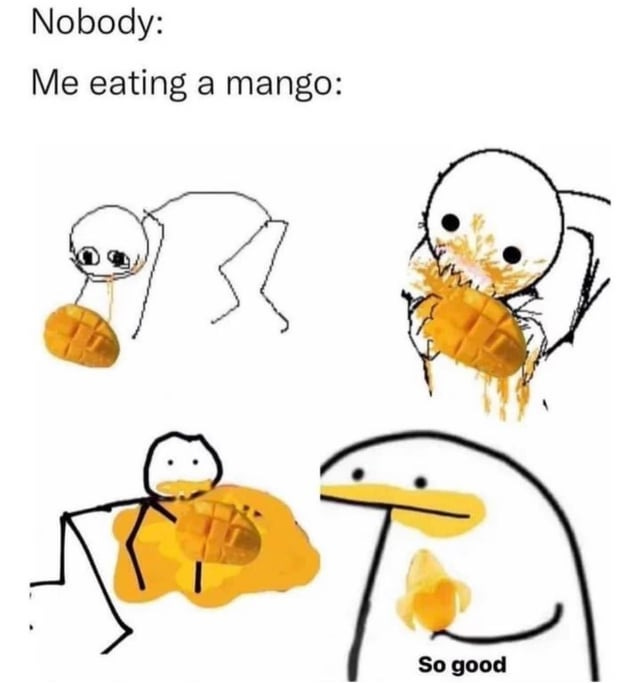With a Mango, I Want to Astonish the Internet!
Why still life paintings are still a thing, plus thoughts about fruit & flesh.
Hello, my Stars.
How are you doing? Have you eaten a piece of fruit today? Would you like another? I’ll wait while you grab one. May I suggest a seckel pear? I’m eating one right now, and it is sweet and floral and gorgeous, and oh-so tiny.
After this newsletter goes out, I’m starting my next painting. Please help me pick a fruit/muse by voting in the poll, and then comment with what produce items you think I should paint in the future! 👀
Why Do Still Lifes Refuse to Die?
The title of this newsletter was inspired by a quote attributed to the painter Cézanne. Here’s a blurb about it from the Met:
Cézanne once proclaimed, "With an apple I want to astonish Paris," and he succeeded, even in his most deceptively simple still lifes, to dazzle and delight.
While artists have painted food and flowers since ancient times, the still life emerged as a full genre in the Netherlands during the 16th century. Later called natures mortes (literally “dead nature”), this subject has persistently captured the interest and imagination of artists and collectors ever since. Traditional art theorists would say still life is considered the lowest category of representational art. And yet, and yet, it continues to be one of the most popular subjects for artists to create and for people to purchase.
Why is the still life so enduring? And what does it mean that it holds our attention (and merits monetary value) despite being diminished by crtitcs? Let’s dig a little deeper…
Exotic Fruit = Status Symbol?
For one, still life artworks represent much more than what meets the eye. In art, a cigar is never just a cigar, an orange is never just an orange. What a human chooses to represent in their art (or to display in their homes) is intrinsically meaningful because someone spent time and attention on it. The objects of our fascination tell us about ourselves, our society, our hopes, our fears, and who/what we think “deserves” to take up space.
In the case of still life art, the particular fruits, veggies, and other inanimate objects in a painting hint at social status or cultural norms of either the artist, the collector, or both. Think of how rare a pineapple would have been in Europe five hundred years ago! Today, the sheer diversity of produce I can purchase for under $10 from any NYC street stall is astounding.
The items in a still life composition can also serve as an allegory, like the apple referring to the Garden of Eden story or grapes and chalices representing Bacchus. Contemporary still life paintings might use different reference points than myths and deities, but they can still refer to widely known touchstones. A half-eaten danish in a crumpled paper bag with a paper cup of coffee for Holly Golightly (perhaps a long cigarette holder and little blue box off to the side). A sprinkled frosted donut and a can of beer for Homer Simpson. A bottle of chianti and a plate of fava beans for Hannibal Lector. You get the idea.
When I pick a fruit to paint, I try to think of all the associations and connotations a viewer might bring to the work. I think of my own personal memories with that fruit. I think of pop culture references to that fruit. I think of the history of that fruit, how and where it was grown. I think of other artistic renderings of that fruit. The etymology of the English term for the fruit.
For me, though, no matter what the answers to these questions are, my mind eventually turns to the human body.
Fruit and The Flesh
I’ve written before about how I view my still life paintings as a form of portraiture, with the fruit standing in for the human body. Fruit has skin wrapped around soft, sweet insides. Juices that flow when the skin is broken. Inedible seeds and seeds that we can crush with our teeth. Importantly, like our bodies, fruit ripens and rots.
I love skin texture. It is one of my favorite things to render, to immerse my brain in (hence the Gesture Drawing series). The Nice Pair series is an extension of that impulse.

Human bodies have often been compared to or aligned with fruits. Think of our modern-day emoji language to hint at NSFW acts! Breasts are a particularly common fruit analogy subject, I think perhaps because the way people (mostly men) handle breasts is similar to how people (mostly women) handle fruit at the grocery store. Appraising, weighing, testing, squeezing, and ultimately consuming.

I prefer using fruits with bumps, blemishes, and uneven skin tones in my art. I am increasingly interested in documenting the rotting process of fruits too. The way skin wrinkles, sags, bruises, softens, and splits. We’ll see where that leads, but in the meantime, if you have two pieces of fruit going “bad”, snap a picture of them and send it my way!
As always, thank you for reading. I’ll be back next week with more musings! I am feeling nostalgic, so it might be a story about my Nonna (and maybe *maybe* her Magic Rice recipe, if I get her permission to share it).
XOXO,
Sam







I’m voting for grapes or cherries next, once you’re done with the next painting (unless you meant something other than fruit, then… give me a few days to come back to this, haha)